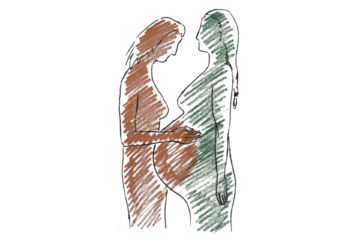| Surrogacy in Russia: An Ethnography of Reproductive Labour, Stratification and Migration
Published by Emerald Publishing ISBN-10: 1839828978, ISBN-13: 978-1839828973 Buy this book from Amazon UK |
 |
While Russia may not seem like an obvious choice for cross-border surrogacy to many, its liberal legal regime actually makes it one of the most permissive places to seek surrogacy. Dr Christina Weis' book Surrogacy in Russia: An Ethnography of Reproductive Labour, Stratification and Migration provides the first in-depth look at surrogacy from the surrogates' perspective, exploring the cultural framing and social organisation of surrogacy. One of the most unique features of Russian surrogacy is how it is 'unapologetically seen as an economic transaction' (page 17). Split into seven chapters, Dr Weis beings by exploring how surrogacy workers, known as 'surmamas', come to be in chapter 2, before focusing on their relationship with the 'client parents' – not 'intended parents' – in chapter 3. The next chapter highlights how surmamas experience geographic and geographic stratification, before closing out the book with an analysis of COVID's impact on the practice of surrogacy in the final chapter. The book's conclusion provides a brief discussion of the future of surrogacy, reflecting on the practice in Russia and beyond.
Surmamas are considered to be working when they undertake surrogacy arrangements, motivated by a desire to overcome income insecurity and doing what they feel confident in and have experience doing: carrying a pregnancy. Like many jurisdictions, surrogates are required to have previously given birth to a healthy child prior to acting as a surrogate. As Dr Weis explains, motherhood 'qua' work is not a foreign concept, culturally speaking: Soviet-era Russia viewed women with children as worker-mothers, working outside of the home and (re)producing the next crop of workers at the same time. The collapse of the Soviet state was accompanied by an outpouring of mothers from the workforce, unable to balance their dual role effectively. Surrogacy is an acceptable form of mother-work as it allows women to re-embrace the 'worker-mother' role doing what they were good at ('mothering' or more specifically, carrying pregnancies) and being reimbursed financially.
Dr Weis' eloquent writing aids the reader in traversing the Russian surrogacy landscape, a foreign jurisdiction that is not often discussed. Surrogacy relationships often discussed in empirical research tend to emphasise surrogates' altruism and (over-estimation of) the emotional bonds forged during their journeys. This stands in stark contrast with the explicitly business-like nature of Russian surrogates' relationships with their intended parents, and surrogates' understanding of their transient and instrumental role in their journeys. Rather than hope for a long-lasting friendship and have that expectation set the tone for the course of their journeys, surmamas understood the emotional work undertaken in surrogacy as included within their workload, since it was part of being a mother.
Californian surrogacy agencies' practices involve explicitly screening out potential applicants who express financial incentives as their primary motive for undertaking surrogacy. By comparison, Russian agencies do the polar opposite: it was undesirable for surrogates to shy away from discussing their economic motivations. While this may shock those who are more comfortable with the presentation of surrogates as 'altruistic angels,' it wasn't nearly as difficult to read as Dr Weis's description of the ethnic, racial, and geographic stratification present in the Russian surrogacy landscape.
Dr Weis' discussion on the reliance on the reproductive labour of women migrating or commuting from neighbouring former Soviet countries and impact of race on surrogates' earning potential and ability to match with intended parents was so carefully written, but still managed to have me turn each page, mouth agape. The devaluation based on ethnicity and/or religion was especially difficult to read, given the apparent acceptance of the pervasiveness of these discriminatory practices. Dr Weis shares one Moldovan surrogate's experiences of feeling humiliated repeatedly by a particular surrogacy agency, despite her best efforts. Dr Weis touches on the migration of Ukrainian surrogates when tensions were high during the early 2010s, and how surrogacy allowed them to leave the conflict zone.
However, political animosity between the two countries meant Russian agencies and intended parents were reluctant to work with any of these migrants. I would be intrigued to read more of her work on surrogates' experiences, given the current political climate.
The final chapter's reflection of surrogacy in Russia during the COVID-19 pandemic was enlightening, as the focus had been primarily on Ukrainian surrogacy at the time. 2020 provided a crossroads for Russian policymakers: ban surrogacy in the interest of protecting Russian family values, or reserve it for the 'right kind of people' to become parents in the national interest.
As the value of sociological exploration into surrogates' experiences is increasingly being recognised, there is a need for more global perspectives on surrogacy. Currently, while there are books written about surrogacy and cross-border reproductive care outside of the West, the focus has been India, and Israel predominantly, with some work conducted on other surrogacy hubs. A few books focus on the various actors involved, however the most part, these texts provide an overview of surrogacy as practiced in an unregulated zone. Dr Weis' book is therefore an excellent and necessary addition to the literature on surrogates' experiences, and a must read for anyone wanting to hear from the voices of those often ignored.
Buy Surrogacy in Russia: An Ethnography of Reproductive Labour, Stratification and Migration from Amazon UK.






Leave a Reply
You must be logged in to post a comment.